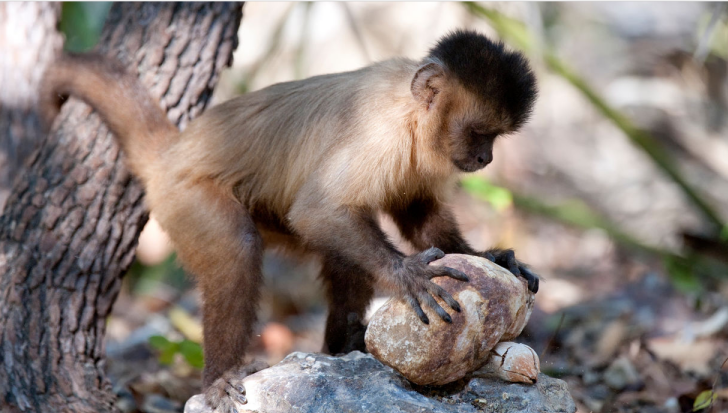One of the most famous edits in cinematic history comes early in "2001: A Space Odyssey".
電影史上最著名的改編之一是《2001太空漫游》。
A primitive hominid hurls a bone club into the air,
原始人類向空中投擲一根骨頭棒
and a match cut to a spacecraft instantaneously tells the millennia-long story of human ingenuity.
一根劃在宇宙飛船上的火柴瞬間講述了人類智慧的千年歷史。
Tools maketh man. But there was never a human monopoly on tool use, as a new paper in Nature Ecology & Evolution shows.
工具造就人。但正如《Nature Ecology & Evolution》期刊的一篇新論文所示,人類從未壟斷過工具的使用。
A team led by Tiago Falotico of the University of Sao Paulo, in Brazil,
巴西圣保羅大學的Tiago Falotico所領導的團隊
and Tomos Proffitt of University College, London,
以及倫敦大學學院的Tomos Proffitt
has demonstrated that a species of monkey called the wild bearded capuchin has been employing stone tools for perhaps 3,000 years,
已證明一種被稱為野生胡子卷尾猴 的種類使用石器的歷史約有3000年,
and that their use of the technology has changed over the course of time.
并且它們對技術的使用也隨時間而發生了變化。
Capuchins, chimpanzees and sea otters, among others, are known to use rocks to crack open, respectively, nuts and shellfish.
已知卷尾猴、大猩猩和海獺分別用巖石來敲開堅果和貝類。
And an earlier dig by Dr Falotico found evidence that, in capuchins, this habit goes back at least 600 years.
Falotico博士早前的一次挖掘發現證據證明,卷尾猴的這一習慣可追溯到至少600年前。

Though some may question whether bashing a nut with a rock truly qualifies as "tool use",
盡管有些人可能會質疑用石頭砸堅果是否真的屬于“工具使用”,
capuchins use both hammerstones and anvils—which demonstrates quite a high level of sophistication.
但卷尾猴使用石錘和鐵砧—這展現了一種相當高水平的復雜性。
They also demonstrate sophistication in the wielding of their tools,
它們還在使用工具方面也表現出老練
because not damaging the soft kernel of a nut while breaking the shell takes skill.
因為在打破堅果殼的時候不破壞軟核需要技巧。
Cracking open a cashew, the favourite for this treatment, requires the tool-wielder to employ a single, practised motion.
敲開腰果需要使用工具的人做一個簡單而熟練的動作。
First, the animal brings the hammerstone down two-handed for a glancing blow on the nut's far side.
首先,動物兩只手把鐵錘石砸下來,側擊堅果的反面。
It then rolls the stone towards itself, over the nut.
然后它把石頭滾向自己,完全覆蓋堅果。
Youngsters take around eight years of mimicking their parents to get the knack of all this.
年輕的幼崽要花約8年的時間模仿它們的父母,才能掌握這一切的訣竅。
And although the stones used are not actually modified for the task,
盡管所使用的石頭實際上并沒有根據任務進行改良,
monkeys are assiduous in searching for and selecting those of the perfect shape.
但猴子們孜孜不倦地尋找和選擇最完美的形狀。
(They do, however, lack the insight to keep such stones for future use.)
(但它們確實缺乏保存這些石頭以備將來使用的洞察力。)
Dr Falotico and Dr Proffitt returned to the site of the previous excavation—a part of Serra da Capivara National Park in the Brazilian Amazon.
Falotico和Proffitt博士返回先前挖掘的地點—巴西亞馬遜地區塞拉·達·卡皮瓦拉國家公園的一部分。
They dug into an area of 67 square metres, to which the monkeys bring stones from a nearby stream bed.
他們挖掘了一片67平方米的區域,猴子們從附近的河床上搬來石頭。
The site's capuchins use quartzite cobbles as hammerstones, and tree limbs and loose stones as anvils.
這片區域的卷尾猴將硅巖鵝卵石用作石錘,將樹枝和裸石用作鐵砧。
譯文由可可原創,僅供學習交流使用,未經許可請勿轉載。



